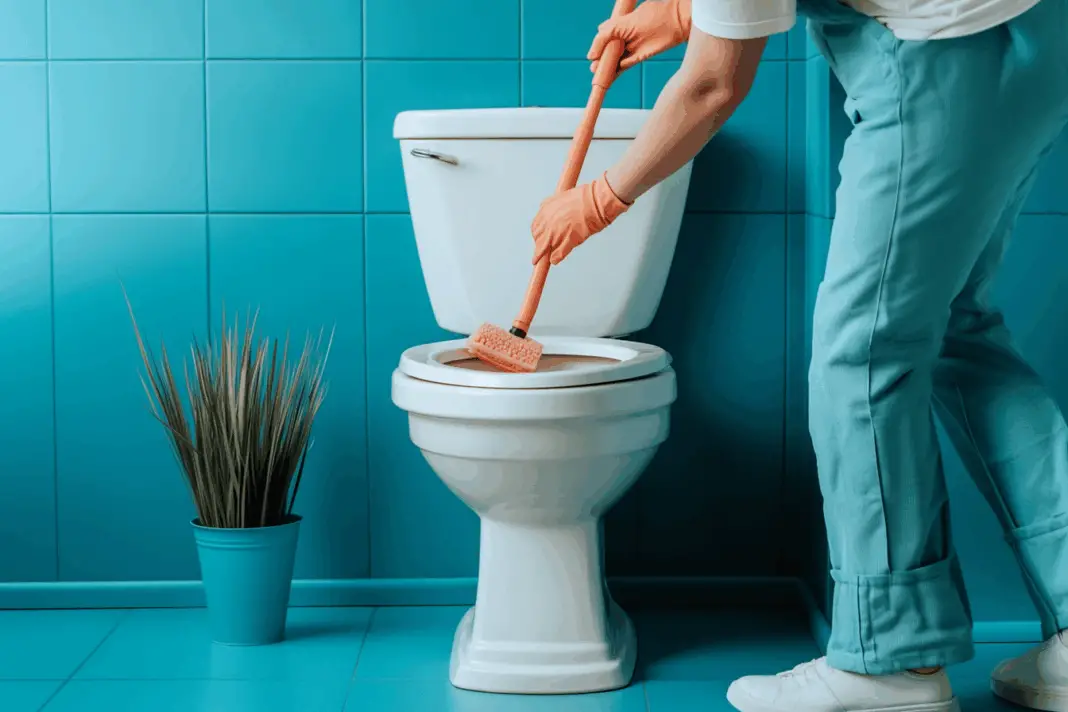We’ve all been there – you scrub and scrub at those stubborn brown rings in your toilet bowl, but they just won’t budge. It’s frustrating, embarrassing, and makes your bathroom look dirty even when everything else is spotless. But here’s the good news: those stubborn stains aren’t permanent! With the right approach and some simple household ingredients, you can transform your toilet from grimy to gleaming in less time than you might think. Ready to make your toilet bowl sparkle again?
Identify what type of stain you’re dealing with first
Before grabbing your cleaning supplies, take a moment to figure out what kind of stain you’re looking at. Different types require different treatments. Brown or reddish streaks are usually rust stains from iron in your water. Yellow stains often come from mineral deposits in hard water. Green or black spots might be mold. And those stubborn water lines? Those are typically mineral deposits that build up over time at the water level. Knowing what you’re dealing with helps you pick the right cleaner instead of wasting time with products that won’t work.
The good news is that most toilet stains aren’t permanent – they just need the right approach. For iron stains, you’ll want something that specifically targets rust, like Iron Out. Mineral deposits respond well to acidic cleaners. Mold needs something with fungicidal properties. And those annoying water lines? They typically need a combination approach. Taking a few seconds to identify your stain type can save you hours of frustration and countless dollars wasted on ineffective cleaning products.
Vinegar and baking soda make a powerful team
Sometimes the most effective cleaners are already sitting in your kitchen cabinet. White vinegar and baking soda create a cleaning powerhouse that works on most toilet stains, especially mineral deposits from hard water. Start by flushing the toilet to get fresh water in the bowl. Then pour about one cup of white vinegar directly into the toilet water, making sure to get it on the stained areas. Next, sprinkle about one cup of baking soda into the bowl and watch as it starts to fizz and bubble – that’s the cleaning magic happening! The fizzing reaction helps lift away stains without harsh chemicals.
Let this vinegar-baking soda mixture sit in your toilet for at least 30 minutes, though an hour is even better for stubborn stains. The longer it sits, the more time it has to break down those tough deposits. After waiting, grab your toilet brush and give everything a good scrub, paying special attention to the stained areas and under the rim. This gentle but effective method works wonders on light to moderate stains and is completely safe for your plumbing. For extra cleaning power, you can even let the mixture sit overnight – just remember to warn your family!
Try lemon juice for a natural acid boost
When regular cleaners aren’t cutting it, lemon juice can be your secret weapon against toilet stains. Lemons contain citric acid, which is particularly effective at dissolving mineral deposits and killing mold. For a simple but powerful cleaner, squeeze the juice from several lemons into a bowl and pour it directly onto the stained areas of your toilet. The natural acids will immediately start working to break down those stubborn marks. Let the lemon juice sit for about 30 minutes to give it time to penetrate the stains. The fresh scent is a nice bonus compared to harsh chemical cleaners!
For an even more powerful cleaning solution, mix that lemon juice with Borax to create a paste. Borax is a natural mineral that enhances the cleaning power of the citric acid and specifically targets those annoying toilet rings. Apply the paste directly to the stained areas and let it sit for at least 30 minutes before scrubbing with your toilet brush. This combination works especially well on stains at the water line, which are often the toughest to remove. Remember to wear gloves when working with Borax, as it can irritate your skin despite being a natural product.
Hydrogen peroxide tackles tough rust stains
If you’re battling those reddish-brown rust stains that seem impossible to remove, hydrogen peroxide might be your new best friend. This common household disinfectant is actually a powerful oxidizer that’s excellent at breaking down rust. Simply pour about one cup of regular 3% hydrogen peroxide into your toilet bowl, focusing on the stained areas. The peroxide will bubble slightly as it starts to work on the stains. Let it sit for at least 30 minutes to give it time to break down those stubborn rust marks. You’ll be amazed at how well it works on stains that other cleaners can’t touch.
For particularly stubborn rust stains, you can make a paste by mixing hydrogen peroxide with cream of tartar or baking soda. Apply this paste directly to the stained areas and let it sit for about an hour before scrubbing. The paste will cling to vertical surfaces better than liquid peroxide alone, giving it more time to work on those tough stains. Unlike some commercial rust removers, hydrogen peroxide won’t damage your porcelain toilet bowl or release harmful fumes. Just be sure to wear gloves as it can temporarily bleach your skin. After scrubbing, flush the toilet to rinse everything away.
Pumice stones safely remove stubborn water lines
For those persistent water line rings that refuse to budge with chemical cleaners, a pumice stone might be your solution. Despite what you might think, a pumice stone won’t scratch your porcelain toilet when used correctly. The key is to always keep both the stone and the toilet wet during cleaning. Before using a pumice stone, soak it in water for about 15 minutes to soften it. Then, with gloves on, gently rub the stone back and forth over the stained areas. You’ll actually see the stain being erased as you work. The pumice is just abrasive enough to remove the stain without damaging the toilet surface.
When shopping for a pumice cleaning stone, look for ones specifically designed for bathroom cleaning like the pumice toilet cleaning stones with handles for easier grip. These are often shaped to fit the curves of your toilet bowl and have a more consistent texture than random pumice stones. Use light pressure and let the stone do the work – there’s no need to press hard. This method works particularly well on mineral deposits and hard water lines that have built up over time. After you’ve removed the stains, flush the toilet to rinse away any residue from the pumice stone.
Citric acid powder is a mineral-fighting powerhouse
When dealing with serious mineral buildup and limescale, citric acid powder might be the answer to your toilet troubles. This concentrated powder form of the same acid found in lemons packs a much stronger punch. You can find citric acid in the canning section of grocery stores or online. To use it, start by draining as much water from your toilet bowl as possible – either by turning off the water supply and flushing, or by forcing water down with a plunger. Then, sprinkle about 3-4 tablespoons of citric acid powder directly onto the stained areas of your toilet bowl.
Let the citric acid work its magic for at least 30 minutes, though a few hours or even overnight will give you the best results for really tough stains. The acid will slowly dissolve mineral deposits, leaving your toilet looking fresh and clean. After waiting, scrub the bowl with your toilet brush and then flush to rinse everything away. Citric acid is especially effective for limescale buildup and mineral deposits from hard water. As a bonus, it’s relatively gentle on plumbing systems compared to some harsh chemical cleaners, making it safer for septic systems and old pipes.
Commercial products that actually work
Sometimes you need to bring in the big guns for toilet stains that won’t budge with household remedies. There are specific commercial cleaners designed to target different types of toilet stains. For rust and iron stains, products like Iron Out or Super Iron Out are incredibly effective. They contain ingredients specifically formulated to dissolve iron deposits. For mineral buildup and limescale, look for cleaners containing hydrochloric acid (sometimes listed as HCl). These powerful descalers can cut through years of buildup, but should be used with caution in well-ventilated areas while wearing gloves and eye protection.
CLR (Calcium, Lime, Rust) remover is another effective option that works on multiple types of stains. For stubborn mold stains, look for products containing benzalkonium chloride or other fungicides. When using any commercial cleaner, be sure to follow the package directions exactly – especially regarding how long to let the product sit before scrubbing. Most commercial cleaners need time to work properly. Also, never mix different toilet cleaners, as this can create dangerous chemical reactions. If one product doesn’t work after proper application, rinse it away completely before trying a different toilet bowl cleaner.
Armed with these methods, you now have multiple weapons to battle even the toughest toilet stains. From simple vinegar and baking soda to specialized commercial products, there’s a solution for every type of stain. Remember that consistent maintenance is your best defense against future buildup. So go ahead and transform your toilet from embarrassing to sparkling – your bathroom will thank you, and you’ll never have to apologize for those unsightly stains again when guests come over!

